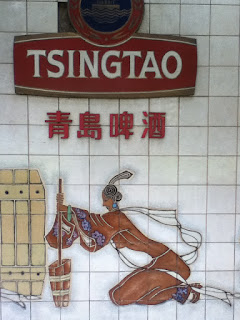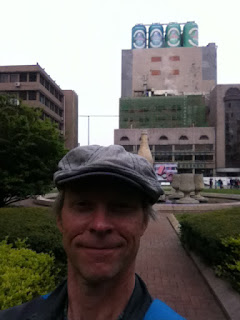“All true paths lead through the mountains.” Gary
Snyder
Tai Shan—the most sacred
mountain in China—has been ascended by emperors and sages, monks and the common
man for thousands of years, and by millions of Chinese, young, old, and in
between in the modern era. You can get to the top by cable car, and a bus even
goes half way up if you want. But however you get there, it is still a large,
imposing, and impressive mountain, maintaining a sense of grandeur even while
man leaves his mark on the stone. Mountains have a way of putting people in
perspective—we are a small part of the world, even though Confucius is supposed
to have said, after seeing the 100 plus mile view from Tai Shan, “The world is
small.”
Each step is small up the
mountain, but there are still seven thousand of them. I did every one of them
and a few more as I ambled about the summit for good measure and viewing
pleasure. There was no cable car for me. I ascended the 4500 vertical foot rise
on my own power, and in good form if I don’t say so.
 |
| 1001, 1002, 1003 ... |
I ended up walking up
with some young Chinese men who were staying at the hostel I was at. One was a
19-year old computer science student at Peking University. He was quite
interested in my views on America and China. So we talked politics and
philosophy for many thousands of steps, which can be a fine way to pass the
time and take your mind off of any pains on a long climb. Another young Chinese
in my group was from Shanghai. He smoked and I easily out walked him. He drove us
to the start of the walk, just a mile or so and a few hundred feet up from our
hostel. With traffic, I think I could have walked up there faster, but when
you’re doing a walk such as this, any extra help is nice.
The traditional start is
at the Temple in town, close to the foot of the mountain, close to my hostel
and the warm Chinese flat bread and soup that we had for breakfast.
The day was crisp and
relatively clear. We were walking up (after paying our $20 climbing fee) by
9:00 AM and we were on top before 1:00. It’s one foot in front of the other up
the stone-paved, often steep path. We walked past and through temples, under
arched gates, past Chinese character inscriptions carved in stone and
highlighted in red, under pines and scholar trees, by small tea shops and stone
toilet buildings.
I passed on the
ever-present walking sticks. But by about 10:30 I grabbed something else to
ease me along—a Red Bull off a pyramid stack of cans sold along the side of the
steps. Energized, we resumed. There are always snacks in China: the sweet tasty
tangerines and salty nuts, packages of crackers, packages of sausages, and
packages of sweets.
Oh mountain climbers you
know, the views kept getting grander the higher you go. The history dripped off
the stone and the reverence seeped from a million trodden feet. Maybe not quite
the way the religious swirl of feeling emanates from Bodh Gaya in India, the
temple in rural India where the Buddha became enlightened. And still different
from the domed, weighty feeling of heaven in the great Christian cathedrals
like St. Peter’s in Rome. The Chinese, perhaps, have a thin but well-woven robe
of religion, trim and serene, like cut flowers placed in a 500-year old
vase.
 |
| Gates, gates-always gates. From one side to another. |
The boys were going back
down the 7000 steps, but I had other plans that would save me some steps this
day and keep me up high for another fine day.
On this mountain top
there’s a wide summit area with a sort of Great Wall-like road. A few
restaurants and shops supply the walkers. As well, there are a couple of
hotels, built of stone, with additional modern accoutrements like full-throttle
wall heaters. The hotels post exorbitant rates, but apparently quickly lower
their rates when demand’s not so great. And it seemed like this was a lower
demand time—early February. I set in my head a rate that I felt comfortable
paying and prepared for some bargaining. If I could get a good rate, I would
stay the night. “Duo Shou?” [how much] and like that I was satisfied and set
for the night. I told my friend to make his way down. I’d send him my thoughts
on the Dali Lama later; tonight I would be looking at the full moon and getting
up the next morning before dawn to see the fabled sunrise that colors the east
red.
 |
| A temple at the top |
My room was small, but it
had a window, a decent bed and thick blankets, a thermos for hot water, even a
TV and a phone, and most important on this cold night, a cranking heater. A
smiling older female employee came in and turned that baby on so that it was
pumping out 85-degree air. I kept it on most of the night. The bathroom was
down the wall. A potable hot water tank was upstairs and the restaurant stayed
open all night.
After warming up, where
would a full-moon aficionado go but to the Moon-Viewing Pagoda. The path, which
was paved in stone, naturally, followed a wind-swept ridge through sparse,
angled pines. The shadowy outlines of the mountains of this part of the
Shandong Peninsula receded into the bright night, while the city lights
twinkled far below.
Back at the hotel, I ate
hot noodles, went to bed and slept until a bit before dawn. I took the pre-dawn
walk to the eastern edge of Tai Shan. I made my way on the wide stone paths to
the edge of the mountain on a rocky promontory where a few other people had
gathered. The more popular “peak for viewing the rising sun” was a few hundred
yards away, wrapped around the rock face. Below me a few hundred feet was a
very small pavilion. Before the orange orb crested the cloud deck horizon far,
far away over the valley, I made my way on a path through a cleft in the
mountain rock and to the pavilion. There I savored the beautiful daylight
effusion. The east turned red over the Yellow River valley 4000 feet below.
As per normal in China, a
restaurant was ready to feed people a hearty breakfast for cheap. A couple of
bucks got me a bowl of steaming hot grain breakfast soup, spiced matchstick
vegetables, a sort of thin, crispy crepe, and a big stack of tube-shaped fry
bread (yoe tiao), which has become my Chinese breakfast go-to, the doughnut of
China.
The day was fine, if cool
again. I set off down the backside of the mountain. I’d scouted the trail the
day before after I checked in. Stone steps led down into a steep valley with
pines whose branches spread horizontally to frame the rock and sky almost like
they were artfully manicured. Indeed a few of them had wire trusses to support
their thick branches. It was a pleasant, natural contrast to the more popular
and populated front ascent. The staircase steps wound steeply down the
mountain. I found solitude and peace in the understory of the forest where
views to the big granite faces were plentiful.
 |
| Going down ... |
There were few structures
on this side of the mountain. One was a small, inviting temple complex built on
a small terrace of level ground. It is called, in English, “The place of the
cultivating of the Jade Girl.” I sat in the sun, against a tall tree and ate
some of my provisions from Ti’an, there being no teahouses on this side of the
mountain.
 |
| Morning Sun |
Thousands of steps I
continued on down, passing a couple of small groups—a small respite from the
mass humanity of China.
A UN official, on his
visit to this national park during his UNESCO world heritage site designation
inspection was supposed to have declared this gorge comparable in beauty to the
Grand Canyon. While not quite as awe-inspiringly grand, this was a beautiful
place, similar to the Sierras or western Colorado Rockies with their mix of
solid rock outcroppings and deep canyons. Here there were no above timberline
spires, though the larch trees atop the mountain would seem to have indicated a
closeness to timberline, much as the smaller alpine larch indicate that zone in
the northern Rockies. The wind-swept, sculptural pines that framed the steep
canyon walls accentuated the beauty of this place.
Along with the stone
paths on Chinese trails come stone gates. My descent began by going through the
ancient North Gate. Much lower was the solid Hurrahing Gate, so called because
the Qing Dynasty troops were said to have “hurrahed” once they reached this
natural pinch point. “Hurrahing” apparently being the same in English and
Chinese—hip, hip hurrah!
 |
| Traveling Through the Trees |
A particularly steep
section of the trail with an angle approaching 40 degree and going for about
500 vertical feet was called the “hero’s section” for the heroic effort needed
to ascend.
The village at the bottom
was a mix of old and new. The new alpine style condos lining the stream seemed
to be wholly unoccupied. Old people carried water jugs to fill from the
springs.
I eventually got on the
only bus out of there, waiting too long since the bus number had changed and my
small Chinese language skills misinterpreted price and bus numbers. The bus
took the high road wrapping around the mountain past manicured pines and
eventually into town and the train station, where I bought my ticket out for
the next morning, with the help of a women.
With the help of another
women who spoke decent enough English, I ordered a fine pork and green bean
stir-fry dish in a small restaurant in an alley close to my hostel. Tai’an
being one of the places where it’s not quite cold enough to have good indoor
heating, but much too cold to expect to eat in a restaurant without your
jacket. This women was a waitress at the restaurant and like the other
waitresses, was dressed in a kind of full-body padded print apron to keep
warm—sort of like a sumo waitress.
After a quick walk the
next morning through the main temple complex, I departed as millions had before
me, fed and enriched with the mountain spirit.
 |
| The Back Side |




































